|
State wise list of Tagetes minuta Growers -2017
|
|
|
|
(Planting material and crop advisory provided by CSIR-IHBT)
|
|
|
|
UTTAR PRADESH
|
|
|
|
|
Sr No
|
Name
|
Address
|
Area sown (Ha)
|
|
|
1
|
Sh Mor Singh
|
GP Gahbra, PO Divna, Tehsil Mirganj, Distt Bareli
|
4
|
|
|
2
|
Babu Ram
|
GP Gahbra, PO Divna, Tehsil Mirganj, Distt Bareli
|
4
|
|
|
3
|
Arvind Singh
|
VPO SakotiTanda, Tehsil Sardhana, Distt Meerut
|
2
|
|
|
4
|
Vishwas Kumar
|
VPO SakotiTanda, Tehsil Sardhana, Distt Meerut
|
1
|
|
| |
|
|
|
|
|
JAMMU &KASHMIR
|
|
|
|
|
1
|
Jointly with CSIR-IIIM Jammu
|
AcrossKupwara district, J&K
|
33
|
|
| |
|
|
|
|
|
MANIPUR
|
|
|
|
|
1
|
Jurist Abonmai and group
|
Makhan Village, PO AwangSekmai, Senapati District, Manipur
|
4
|
|
| |
|
|
|
|
|
HIMACHAL PRADESH
|
|
|
|
|
1
|
Sh. Pritam Singh
|
S/o Sh. SharanPatra VPO Raila Tehsil SainjDistt. Kullu
|
0.8
|
|
|
2
|
Sh. Vijay Bhusan
|
S/O sh. Hukum Ram Village Ziva PO Riala Tehsil SainjDistt. Kullu
|
0.8
|
|
|
3
|
Sh. Tikkam Ram
|
S/O Moti Ram Village Saram PO Raila Tehsil SainjDisttKullu
|
0.6
|
|
|
4
|
Sh. Lottam Ram
|
S/O Sh. Chait Ram Village Saran PORaila Tehsil SainjDistt. Kullu
|
0.8
|
|
|
5
|
Sh. Pritam Chand
|
S/O Karam Das Village Saran PO Raila Tehsil SainjDistt. Kullu
|
0.8
|
|
|
6
|
Sh. Sangat Ram
|
S/O Sh. Narpat Village Saran PO Raila Tehsil Sainj Dist. Kullu
|
0.4
|
|
|
7
|
Sh. Krisan Chand
|
S/O Sh. Thakar Das Village Saran PO Raila Tehsil Sainj Dist. Kullu
|
0.8
|
|
|
8
|
Sh. Rapti Ram
|
Village Barail PO SainjKullu (H.P)
|
0.8
|
|
|
9
|
Sh. Roop Lal
|
Vill. Dingcha PO GhushaniRopa Tehsil Banjar Kullu (H.P)
|
0.8
|
|
|
10
|
Sh. Kham Singh
|
Village Shajahu JPO Anna Tehsil Banjar Kullu (H.P)
|
0.8
|
|
|
11
|
Smt. Bhaja Devi
|
Village Jummad VPO Platch Tehsil Banjara (H.P)
|
0.8
|
|
|
12
|
Smt. Reena Devi
|
VPO Platch Tehsil Banjara (H.P)
|
0.8
|
|
|
13
|
Sh. Rakesh Kumar
|
VPO Platch Tehsil Banjara (H.P)
|
0.5
|
|
|
14
|
Sh. Kham Chand
|
VPO Manglore Tehsil Banjar Kullu (H.P)
|
0.6
|
|
|
15
|
Sh. Rajendera Singh
|
Village Dhuri PO Kalwari Tehsil Banjar Kullu (H.P)
|
0.6
|
|
| |
|
|
|
|
|
MANIKARAN, KULLU
|
|
|
|
1
|
ShParmanand&group
|
Village Dehnidhar, P.P. Neoli, Tehsil and District Kullu
|
19
|
|
|
2
|
ShVineetsood&group
|
Village Dehnidhar, P.P. Neoli, Tehsil and District Kullu
|
-
|
|
| |
|
|
|
|
|
THE. BANJAR, KULLU
|
|
|
|
1
|
Sh. Bhaga Devi
|
VPO Kalwari, Tehsil Banjar
|
0.16
|
|
|
2
|
Sh. SurenderRathor
|
VPO Kalwari, Tehsil Banjar
|
0.24
|
|
|
3
|
Sh. Pyaee Ram
|
VPO Kalwari, Tehsil Banjar
|
0.16
|
|
|
4
|
Sh. Davinder
|
VPO Kalwari, Tehsil Banjar
|
0.5
|
|
|
5
|
Sh. Ravesh
|
VPO Kalwari, Tehsil Banjar
|
0.16
|
|
|
6
|
Sh. Rajender Chauhan
|
VPO Kalwari, Tehsil Banjar
|
0.08
|
|
|
7
|
Sh. Om Prakesh
|
VPO Kalwari, Tehsil Banjar
|
0.4
|
|
|
8
|
Sh. Mohinderlal
|
VPO Kalwari, Tehsil Banjar
|
0.5
|
|
|
9
|
Ghanshyan Singh
|
VPO Kalwari, Tehsil Banjar
|
0.24
|
|
|
10
|
Durga Singh
|
VPO Kalwari, Tehsil Banjar
|
0.16
|
|
|
11
|
Teja Singh
|
VPO Kalwari, Tehsil Banjar
|
0.16
|
|
|
12
|
Sh. Kem Singh
|
VPO Kalwari, Tehsil Banjar
|
0.24
|
|
|
13
|
Sh. Roop Lal
|
VPO Kalwari, Tehsil Banjar
|
0.24
|
|
|
14
|
Sher Singh
|
VPO Kalwari, Tehsil Banjar
|
0.6
|
|
| |
|
|
|
|
|
SAMOT, CHAMBA
|
|
|
|
1
|
Sh. Pawan Ex pardhan
|
Village SurpadhaBhatiyatDistt. Chamba (H.P)
|
0.56
|
|
|
2
|
Sh. Rakesh kumara Sharma
|
Village SurpadhaBhatiyatDistt. Chamba (H.P)
|
0.16
|
|
|
3
|
Sh. Chain Singh
|
Village Majhoi PO Samot G.P.SurpandaDistt. Chamba
|
0.08
|
|
|
4
|
Sh. Parval Singh
|
Village Majhoi PO Samot G.P.SurpandaDistt. Chamba
|
0.4
|
|
|
5
|
Sh. Niku Ram S/O Machlo
|
Village Ghumrahar PO parsiyaraBhtiyatDistt. Chamba
|
0.4
|
|
|
6
|
Sh. Ram Mal S/O Munshi Ram Village
|
Village Ghumrahar PO parsiyaraBhtiyatDistt. Chamba
|
0.8
|
|
|
7
|
Kanshi Ram Sharma
|
Village Gond PO Parsiyara G.P SurpadhaDistt. Chamba
|
0.6
|
|
| |
|
|
|
|
|
TEH. SALOONI, CHAMBA
|
|
|
|
1
|
Bhuto Khan
|
VPO Maida, Tehsil Salooni, Chamba
|
1.5
|
|
|
2
|
Farooq Khan
|
VPO Maida, Tehsil Salooni, Chamba
|
1
|
|
| |
|
|
|
|
|
THE. BHATIYAT, CHAMBA
|
|
|
|
1
|
Kartar Singh
|
Village Bhutal PO GharuVanet Tehsil BhatiyatDistt. Chamba (H.P)
|
0.8
|
|
|
2
|
Pawan Kumar
|
Village Jhuled PO GharuVanet TehsilBhatiyatDistt. Chamba (H.P)
|
0.16
|
|
|
3
|
Vachitar Singh
|
Village Kawar PO GharuVanetTehsil BhatiyatDistt. Chamba (H.P)
|
0.8
|
|
|
4
|
Pawan Singh
|
Village Kawar PO GharuVanetTehsil BhatiyatDistt. Chamba (H.P)
|
0.16
|
|
|
5
|
Sanjay Kumar
|
Village Vanet PO GharuVanet Tehsil BhatiyatDistt. Chamba (H.P)
|
0.16
|
|
|
6
|
Jeeta Ram
|
Village Vanet PO GharuVanet Tehsil BhatiyatDistt. Chamba (H.P)
|
0.16
|
|
|
7
|
Satpal Singh
|
Village Bhutal PO GharuVanet Tehsil BhatiyatDistt. Chamba (H.P)
|
0.16
|
|
| |
|
|
|
|
|
GRAM PANCHAYAT, JANDROG, CHAMBA
|
|
|
|
1
|
Sanjeev Singh
|
S/O Sh. Karam Chand Village Kut PO Jandrog Tehsil BhtiyatDistt. Chamba
|
0.48
|
|
|
2
|
Karnel Singh
|
S/O sh. Munshi Ram Village KutJhuled PO JandrogTehsil BhatiyatDistt. Chamba (H.P)
|
0.16
|
|
|
3
|
Ashoke Kumar
|
S/O Sh. Chain Singh VillageChihun PO Jandrog Tehsil BhatiyatDistt. Chamba (H.P)
|
0.08
|
|
|
4
|
Ramesh Singh
|
S/O Sh. Kishan Chan Village Chihun POJandrog Tehsil BhatiyatDistt. Chamba (H.P)
|
0.48
|
|
|
5
|
Kesar Singh
|
S/O Sh. Amar Singh PO JandrogTehsil BhatiyatDistt. Chamba (H.P)
|
0.16
|
|
|
6
|
Mohinder Singh
|
S/O BalvanLahat PO Village Tehsil BhatiyatDistt. Chamba (H.P)
|
0.08
|
|
| |
|
|
|
|
|
VILL. THALLA, DIST. CHAMBA
|
|
|
|
1
|
Tilak Raj
|
S/O Sh. PrabhuDyal
|
0.16
|
|
|
2
|
Ramesh
|
S/O Sh. Jeevan
|
0.08
|
|
|
3
|
Bajro Devi
|
S/O Sh. Budhiya
|
0.04
|
|
|
4
|
Karam Singh
|
S/O Sh. Hardev
|
0.08
|
|
|
5
|
Gian Chand
|
S/O Sh. Nardev
|
0.04
|
|
|
6
|
Rumal Singh
|
S/O Sh. PrabhuDyal
|
0.08
|
|
| |
|
|
|
|
|
KISAN CLUB, BADGAON, BILASPUR
|
|
|
|
1
|
Pankaj Chand
|
VPO Badgaon Tehsil JandhutaDistt. Bilaspur H.P
|
0.08
|
|
|
2
|
Nandkishore Chand
|
VPO Badgaon Tehsil JandhutaDistt. Bilaspur H.P
|
0.16
|
|
|
3
|
Subham Kumar
|
VPO Badgaon Tehsil JandhutaDistt. Bilaspur H.P
|
0.08
|
|
|
4
|
Rishi Ram
|
VPO Badgaon Tehsil JandhutaDistt. Bilaspur H.P
|
0.08
|
|
|
5
|
Narender Singh
|
VPO Badgaon Tehsil JandhutaDistt. Bilaspur H.P
|
0.08
|
|
|
6
|
Sanjay Kumar
|
VPO Badgaon Tehsil JandhutaDistt. Bilaspur H.P
|
0.08
|
|
|
7
|
Munisha Ram
|
VPO Badgaon Tehsil JandhutaDistt. Bilaspur H.P
|
0.08
|
|
|
8
|
Jasmit Singh
|
VPO Badgaon Tehsil JandhutaDistt. Bilaspur H.P
|
0.08
|
|
|
9
|
Pavinder Kumar
|
VPO Badgaon Tehsil JandhutaDistt. Bilaspur H.P
|
0.08
|
|
|
10
|
Karam Chand
|
VPO Badgaon Tehsil JandhutaDistt. Bilaspur H.P
|
0.08
|
|
| |
|
|
|
|
|
VILL. PADDHAR, JOG.NAGAR, MANDI
|
|
|
|
1
|
Sh. Darshan Lal
|
S/o Barkhu Ram V. siunp.opaddhar tehsil paddharDistt. Mandi(H.P)
|
1.2
|
|
|
2
|
Sh. Deena Nath
|
S/o Birvam Ram V. sakrogp.opaddhar tehsil paddharDistt. Mandi(H.P)
|
0.5
|
|
|
3
|
Sh. Jaswat
|
S/o KrishanChand V.siunp.opaddhar tehsil paddharDistt. Mandi(H.P)
|
1
|
|
|
4
|
Sh. Mahender Singh
|
S/o Lal Chand V. surahugp.opaddhar tehsil paddharDistt. Mandi(H.P)
|
0.5
|
|
|
5
|
Sh. HemRaj
|
S/o Daya Ram V. surahugp.opaddhar tehsil paddharDistt. Mandi(H.P)
|
1
|
|
|
6
|
Sh. Budhi Singh
|
S/o Hira Ram V.siunp.opaddhar tehsil paddharDistt. Mandi(H.P)
|
0.8
|
|
|
7
|
Sh. Mann Singh
|
S/o Narotam V. surahugp.opaddhar tehsil paddharDistt. Mandi(H.P)
|
0.8
|
|
|
8
|
Sh. Kasmir Singh
|
S/o Kanshi Ram V. siunp.opaddhar tehsil paddharDistt. Mandi(H.P)
|
0.4
|
|
|
9
|
Sh. Kala Ram
|
S/o Narotam V. surahugp.opaddhar tehsil paddharDistt. Mandi(H.P)
|
0.8
|
|
|
10
|
Sh. Viri Singh
|
S/o Daya Ram V. siunp.opaddhar tehsil paddharDistt. Mandi(H.P)
|
1
|
|
|
11
|
Sh. Parash Ram
|
S/o Hem chand V. siunp.opaddhar tehsil paddharDistt. Mandi(H.P)
|
0.8
|
|
|
12
|
Sh. Bihari Lal
|
S/o Mangru V. siun V. siunp.opaddhar tehsil paddharDistt. Mandi(H.P)
|
1
|
|
|
13
|
Sh. Ramesh Chand
|
S/o DayaRam V.siunp.opaddhar tehsil paddharDistt. Mandi(H.P)
|
0.8
|
|
|
14
|
Sh. Jagdeesh Chand
|
S/o Kapuru V. siunp.opaddhar tehsil paddharDistt. Mandi(H.P)
|
0.6
|
|
|
15
|
Sh. Mohan Singh
|
S/o Kanshi Ram V. siunp.opaddhar tehsil paddharDistt. Mandi(H.P)
|
0.5
|
|
|
16
|
Sh. Sudama
|
S/o Barkhu Ram V. siunp.opaddhar tehsil paddharDistt. Mandi(H.P)
|
0.6
|
|
|
17
|
Sh. Surender
|
S/o Lakhu Ram V. siunp.opaddhar tehsil paddharDistt. Mandi(H.P)
|
0.6
|
|
|
18
|
Sh. Parash Ram
|
S/o Tulla Ram V. siunp.opaddhar tehsil paddharDistt. Mandi(H.P)
|
0.4
|
|
|
19
|
Sh. Bhaba Ram
|
S/o Tulla Ram V. siunp.opaddhar tehsil paddharDistt. Mandi(H.P)
|
1
|
|
|
20
|
Sh. Bhale Ram
|
S/o Tulla Ram V. siunp.opaddhar tehsil paddharDistt. Mandi(H.P)
|
0.4
|
|
|
21
|
Sh. Manohar Lal
|
S/o Tulla Ram V. siunp.opaddhar tehsil paddharDistt. Mandi(H.P)
|
0.5
|
|
|
22
|
Sh. Naraotam
|
S/o Bhudhu Ram V. siunp.opaddhar tehsil paddharDistt. Mandi(H.P)
|
0.8
|
|
|
23
|
Sh. Prem Singh
|
S/o Hulku Ram V. siunp.opaddhar tehsil paddharDistt. Mandi(H.P)
|
1
|
|
|
24
|
Sh. Hem Raj
|
S/o Aatma Ram V. siunp.opaddhar tehsil paddharDistt. Mandi(H.P)
|
0.8
|
|
|
25
|
Sh. Ramesh Chand
|
S/o Aatma Ram V. siunp.opaddhar tehsil paddharDistt. Mandi(H.P)
|
0.8
|
|
|
26
|
Sh. Sakhti Chand
|
S/o Haru Ram V. sakrogp.opaddhar tehsil paddharDistt. Mandi(H.P)
|
1
|
|
|
27
|
Sh. Tara Chand
|
S/o Gyanu Ram V. sakrogp.opaddhar tehsil paddharDistt. Mandi(H.P)
|
0.3
|
|
|
28
|
Sh. Nota Ram
|
S/o Hardev V. sakrogp.opaddhar tehsil paddharDistt. Mandi(H.P)
|
1
|
|
|
29
|
Sh. Layak Chand
|
S/o Kaalu Ram V. sakrogp.opaddhar tehsil paddharDistt. Mandi(H.P)
|
0.6
|
|
|
30
|
Surender Singh
|
S/o Jeeta Ram V. sakrogp.opaddhar tehsil paddharDistt. Mandi(H.P)
|
0.2
|
|
| |
|
|
|
|
|
VPO NOHALI, JOG. NAGAR, MANDI
|
|
|
|
1
|
Anil Rana
|
S/o Thakur Singh v.ponohali Tehsil JogindernagarDistt. Mandi
|
0.4
|
|
|
2
|
BhalChander
|
S/o Todar Ram v. batnaaharp.onohali tehsil JogindernagarDistt. Mandi
|
0.64
|
|
|
3
|
Chamaaru Ram
|
S/o Nanku Ram v. chaamp.onohali tehsil JogindernagarDistt. Mandi
|
0.16
|
|
|
4
|
Virender Chauhan
|
S/o Thakur singh v. sajehudp.onohali tehsil JogindernagarDistt. Mandi
|
0.24
|
|
|
5
|
Bhavani Singh
|
S/o Sher Singh v. chaam - braadup.onohali tehsil JogindernagarDistt. Mandi
|
0.16
|
|
|
6
|
Khem Chand
|
v. chaam - braadup.onohali tehsil JogindernagarDistt. Mandi
|
0.4
|
|
|
7
|
Mohan Singh
|
v. chaam - braadup.onohali tehsil JogindernagarDistt. Mandi
|
0.08
|
|
|
8
|
Jamsher Singh
|
v. Chaambp.obhyu tehsil jogindernagarDistt. Mandi
|
0.4
|
|
|
9
|
Sh. Parash Ram
|
v. Chaambp.obhyu tehsil jogindernagarDistt. Mandi
|
0.4
|
|
|
10
|
Sh. Naraotam
|
v. Chaambp.obhyu tehsil jogindernagarDistt. Mandi
|
0.4
|
|
|
11
|
Jeeta Ram
|
v. Chaambp.obhyu tehsil jogindernagarDistt. Mandi
|
0.4
|
|
|
12
|
Durga Singh
|
v. Chaambp.obhyu tehsil jogindernagarDistt. Mandi
|
0.4
|
|
| |
|
|
|
|
|
UTTARAKHAND
|
|
|
|
|
|
S. No.
|
Name Of Farmer
|
Address
|
Area (Ha)
|
|
|
1
|
Neeraj Tiwari
|
Vill. Padli, Block Betalghat, PO Ratighat Dist. Nainital
|
0.3
|
|
|
2
|
Bhagirathi Devi w/o Dalip Singh
|
Vill. Sunkiya Block Dhari, Mukteshwar, Dist. Nainital
|
0.3
|
|
|
3
|
Bachuli Devi w/o Kishan Singh
|
Vill. Sunkiya Block Dhari, Mukteshwar, Dist. Nainital
|
0.3
|
|
|
4
|
Gopuli Devi w/o Kundan Singh
|
Vill. Sunkiya Block Dhari, Mukteshwar, Dist. Nainital
|
0.3
|
|
|
5
|
Dr. Tara Singh
|
Biotech Department, Kumaun University, Nainital
|
0.3
|
|
|
6
|
Tara Singh
|
Vill. Sunkiya Block Dhari, Mukteshwar, Dist. Nainital
|
0.3
|
|
|
7
|
Bhawan Singh
|
Vill. Sunkiya Block Dhari, Mukteshwar, Dist. Nainital
|
0.3
|
|
|
8
|
Puran Singh
|
Vill. Sunkiya Block Dhari, Mukteshwar, Dist. Nainital
|
0.3
|
|
|
9
|
Laxman Bharti
|
Vill. Sunkiya Block Dhari, Mukteshwar, Dist. Nainital
|
0.3
|
|
|
10
|
Harish Singh
|
Vill. Sunkiya Block Dhari, Mukteshwar, Dist. Nainital
|
0.3
|
|
|
11
|
Dr. Narayan Singh
|
TERI, Mukteshwar, Dist. Nainital
|
|
|
| |
|
|
121.02
|
|
|
Rosa damascena (Damask Rose)
|
|
|
|
Himachal Pradesh
|
|
|
|
|
|
Sr. No.
|
Name of Farmer
|
Address
|
No. of Cuttings/Rooted Plant
|
|
|
1
|
Shishu Patial
|
Kandbari, Palampur, H.P
|
1000 rooted plants
|
|
|
2
|
Gyan Chand
|
Vill Voat, PO Kamand, Dist. Mandi
|
5000 stem cuttings
|
|
|
3
|
SAHAR Society for Scientific advance of hilly and rural area
|
Vill. Khundan, P.O. Banjar, Dist. Kullu
|
2500 stem cuttings
|
|
| |
|
|
|
|
|
UTTARAKHAND
|
|
|
|
|
|
1
|
Neeraj Tiwari
|
Vill Padli, Block Betalghat, Dist. Nainital
|
400 stem cuttings
|
|
|
2
|
Bhupal Singh Mehra
|
Vill. Bajun, Dist. Nainital
|
600 stem cuttings
|
|
| |
|
|
|
|
|
MANIPUR
|
|
|
|
|
|
1
|
|
Vill. Makhan, Manipur
|
1000 stem cuttings
|
|
| |
|
|
|
|
| |
|
|
|
1
|
Vijay Kumar
|
Badaun, Uttar Pradesh
|
5000 stem cuttings
|
|
| |
|
|
|
|
|
LEMON GRASS
|
|
|
|
PUNJAB
|
|
|
|
|
|
1.
|
Dr. kawar
|
Pathankot
|
|
|
|
2.
|
Sh. Ishwer Sing Pathania
|
Dhar Block, Pathankot
|
|
|
|
3.
|
Cap. Dhyan Singh
|
Dhar Block, Pathankot
|
|
|
| |
|
|
|
|
|
HIMACHAL PRADESH
|
|
|
|
1.
|
Sh. Hem Raj
|
Vill: Dharer, Post: Kandi, Teh: Palampur, Kangra
|
9817740600
|
|
|
2.
|
Sh. VisheswerPrashad
|
Sirmore
|
9418265821
|
|
|
3.
|
Sh. Gopal Krishna Das
|
Palampur
|
|
|
|
4.
|
Sh. Raman Awasthi
|
Chimbalhar, GithaPeeth, Palampur
|
9816509546
|
|
|
5.
|
Sh S.K. Dogra
|
Draman, Shunta, Chamba
|
9418060877
|
|
|
7018752030
|
|
|
6.
|
Sh. Multan Singh
|
Ziara, Kangra
|
9882993517
|
|
|
7.
|
Sh. M. Komal
|
Uthargram, Kangra
|
8894839210
|
|
|
8.
|
Sh. Bhug Singh
|
Vill. Samariyal, Po. Punchrukhi, The. Palampur
|
9459646417
|
|
|
9.
|
Sh. Goragh Ram
|
Punchrukhi, Palampur
|
-
|
|
|
10.
|
Sh. Mahajan Ram
|
Punchrukhi, Palampur
|
-
|
|
|
11.
|
Sh. Roshan Lal,
|
Punchrukhi, Palampur
|
-
|
|
|
12.
|
Sh. Lekh Raj Rana
|
GarhBasdi
|
9816235715
|
|
|
13.
|
Sh. Omprakesh
|
Paragpur
|
9816318031
|
|
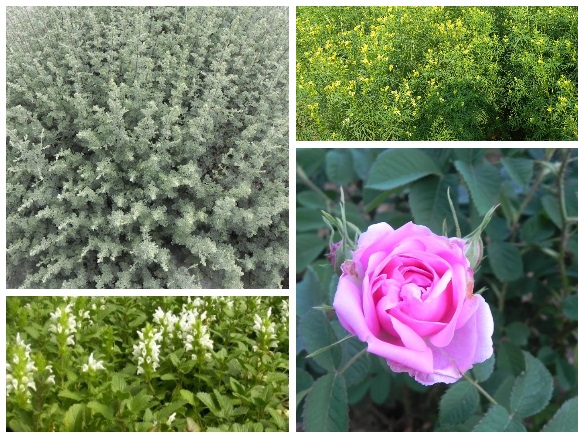
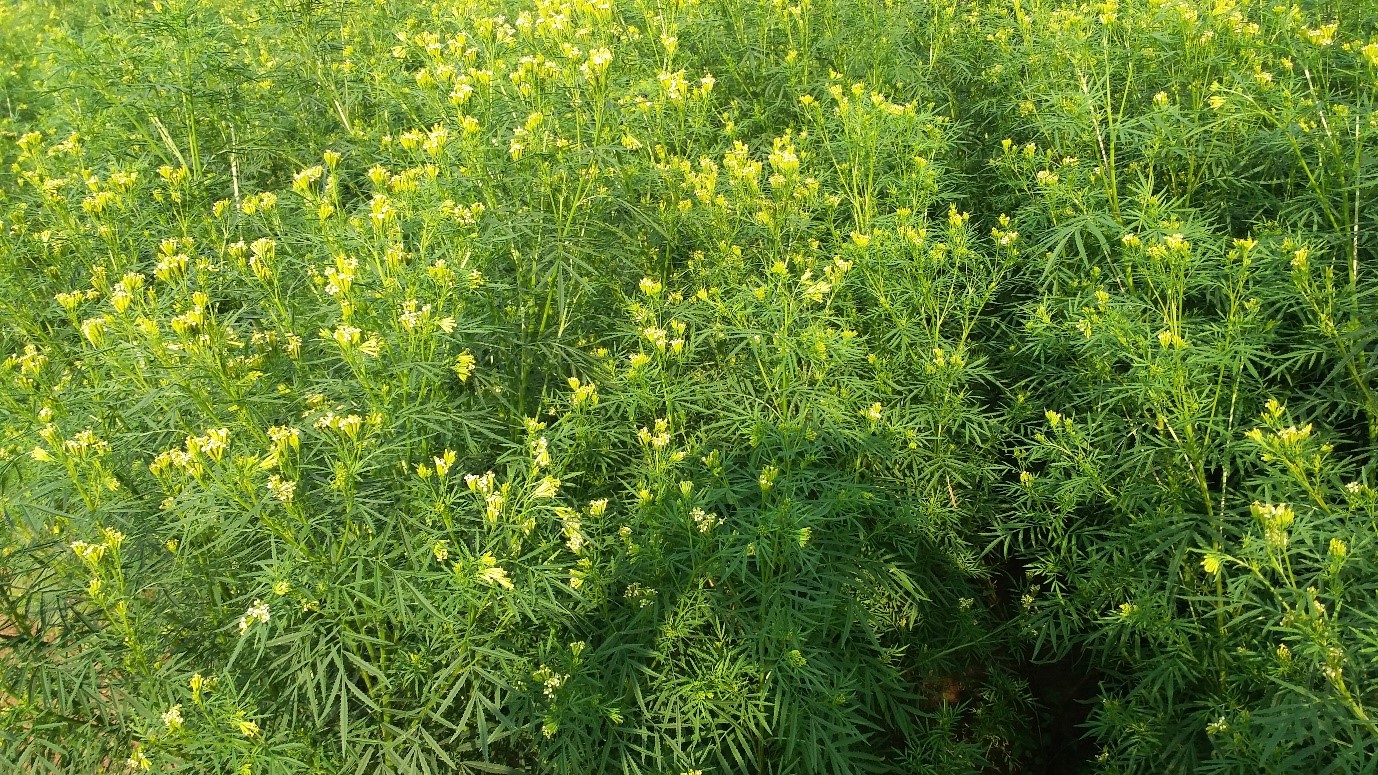 It is a hardy plant and suitable for mid Himalayan region. Crop gives higher oil yield of better quality among all cultivated species. Institute has standardized agro- and processing technologies and released an improved variety “Himgold”. By adopting standardized agrotechnology, crop biomass upto 200 q/ha can be harvested. The oil content ranges between 0.25 to 0.40%. Major constituents of the Tagetes oil are Ocimene (Z and E) , Limonene, Dihydro tagetone, Tagetone (Z and E). The oil used in blending high grade perfumes. The crop gives a net return of Rs 1.5 to 2.00 lakhs per hectare.
It is a hardy plant and suitable for mid Himalayan region. Crop gives higher oil yield of better quality among all cultivated species. Institute has standardized agro- and processing technologies and released an improved variety “Himgold”. By adopting standardized agrotechnology, crop biomass upto 200 q/ha can be harvested. The oil content ranges between 0.25 to 0.40%. Major constituents of the Tagetes oil are Ocimene (Z and E) , Limonene, Dihydro tagetone, Tagetone (Z and E). The oil used in blending high grade perfumes. The crop gives a net return of Rs 1.5 to 2.00 lakhs per hectare.
 It is important species among the scented roses. The plant is perennial shrub with economic life of over is 10 years. The rose can be grown from 250 to 2500 m altitude in sub tropical to temperate climate. The rose flowers produce highly fragrant and commercially valuable essential oil and its content in the flowers is 0.025%. About 25-30 q/ha fresh flowers are harvested from one ha area which produce 0.625 kg rose oil. The market price of oil ranges between Rs. 5.0 to 6.0 lakh/kg. After deducting all costs, this crop gives an average net return of Rs. 2.00 lakh/ha. Other products from damask rose are rose concrete, rose absolute & rose water.
It is important species among the scented roses. The plant is perennial shrub with economic life of over is 10 years. The rose can be grown from 250 to 2500 m altitude in sub tropical to temperate climate. The rose flowers produce highly fragrant and commercially valuable essential oil and its content in the flowers is 0.025%. About 25-30 q/ha fresh flowers are harvested from one ha area which produce 0.625 kg rose oil. The market price of oil ranges between Rs. 5.0 to 6.0 lakh/kg. After deducting all costs, this crop gives an average net return of Rs. 2.00 lakh/ha. Other products from damask rose are rose concrete, rose absolute & rose water.
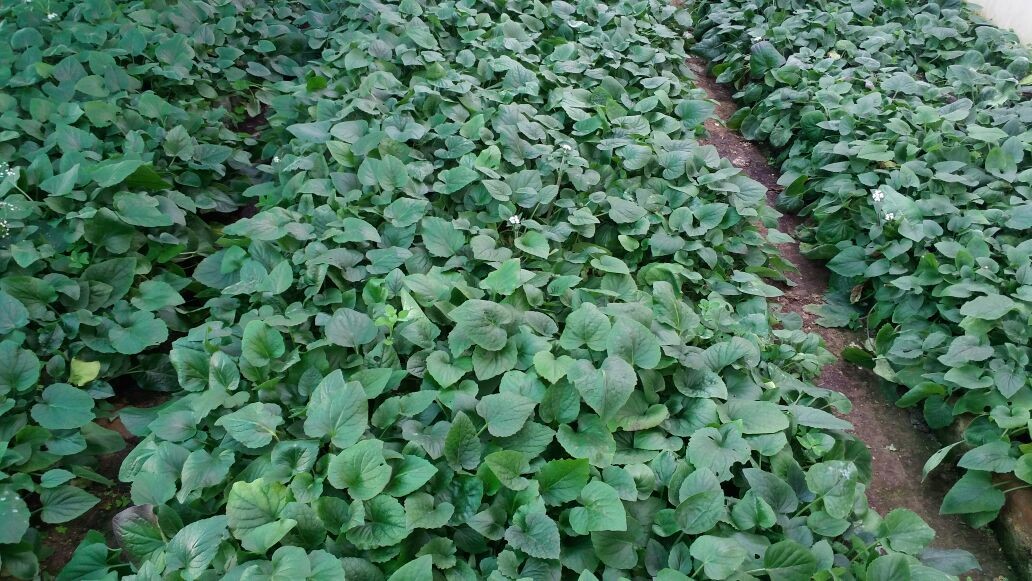 Valeriana jatamansi is an important medicinal herb of the valerianceae family, which is commonly known as Indian Valerian (English), Muskbala, Sugandhbala (Hindi) and Tagar (Sanskrit). V. jatamansi has long been in use in the Ayurvedic and Unani system of medicine. It grows in temperate zones of the western Himalaya at an altitude of 1300-3300 m asl,. Valeriana jatamansi can be propagated by seed or by using portions of the root- stock. The rooted propagules are planted in the field in June-July, while seedlings are transplanted in August at higher elevations and in October at lower elevations. On an average, the yield of dried roots is 0.8-1 tonnes/ha in the second year. However, dried root yields of 1500 kg/ha are available under good conditions. Indian valerian root and rhizomes yields volatile oil upto 0.5-2.12%. An average oil yield was obtained around 15 kg /ha. The market value of dried roots and rhizomes of mushkbala depends on quality and degree of processing and ranges from Rs. 180-200/kg. The current price of valerian oil is about Rs. 25000/kg.
Valeriana jatamansi is an important medicinal herb of the valerianceae family, which is commonly known as Indian Valerian (English), Muskbala, Sugandhbala (Hindi) and Tagar (Sanskrit). V. jatamansi has long been in use in the Ayurvedic and Unani system of medicine. It grows in temperate zones of the western Himalaya at an altitude of 1300-3300 m asl,. Valeriana jatamansi can be propagated by seed or by using portions of the root- stock. The rooted propagules are planted in the field in June-July, while seedlings are transplanted in August at higher elevations and in October at lower elevations. On an average, the yield of dried roots is 0.8-1 tonnes/ha in the second year. However, dried root yields of 1500 kg/ha are available under good conditions. Indian valerian root and rhizomes yields volatile oil upto 0.5-2.12%. An average oil yield was obtained around 15 kg /ha. The market value of dried roots and rhizomes of mushkbala depends on quality and degree of processing and ranges from Rs. 180-200/kg. The current price of valerian oil is about Rs. 25000/kg.
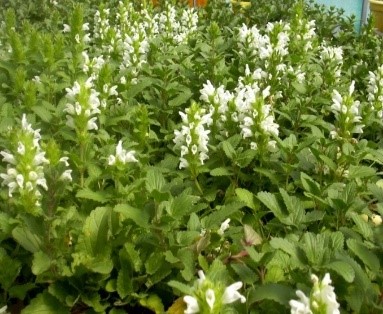 Dracocephalum heterophyllum prefers sub-humid and sub- temperate climate conditions. It grows well in sandy loam soils rich in organic matter (humus) content with adequate moisture and good drainage. The rooted propagules are planted in the field during June-July, while seedlings are transplanted in August at higher elevations and in October at lower elevations. The average yield on fresh weight basis is 4-7 tones/year under good conditions. Fresh parts contain 0.17-0.45 % essential oil.
Dracocephalum heterophyllum prefers sub-humid and sub- temperate climate conditions. It grows well in sandy loam soils rich in organic matter (humus) content with adequate moisture and good drainage. The rooted propagules are planted in the field during June-July, while seedlings are transplanted in August at higher elevations and in October at lower elevations. The average yield on fresh weight basis is 4-7 tones/year under good conditions. Fresh parts contain 0.17-0.45 % essential oil.
 Lemongrass is a tropical perennial plant which yields aromatic oil on steam distillation of the herbage. The oil has a typical lemon-like odour. The crop is suitable for marginal and waste lands in tropical and subtropical areas. It is the principal source of carotene which is extensively used for the synthesis of viamin A and a number of other chemicals including synthetic violet perfumes. The biomass production is 20-25 MT/ha/year. It is less in first year but it increases in the subsequent years. Oil content ranges from 0.4 to 0.6%. Citral is the major constituent in the oil. The oil finds uses in perfumery, flavouring and pharmaceutical industries. Net profit of Rs 1.0 to 1.5 lakhs/ha is obtainable with its scientific cultivation
Lemongrass is a tropical perennial plant which yields aromatic oil on steam distillation of the herbage. The oil has a typical lemon-like odour. The crop is suitable for marginal and waste lands in tropical and subtropical areas. It is the principal source of carotene which is extensively used for the synthesis of viamin A and a number of other chemicals including synthetic violet perfumes. The biomass production is 20-25 MT/ha/year. It is less in first year but it increases in the subsequent years. Oil content ranges from 0.4 to 0.6%. Citral is the major constituent in the oil. The oil finds uses in perfumery, flavouring and pharmaceutical industries. Net profit of Rs 1.0 to 1.5 lakhs/ha is obtainable with its scientific cultivation
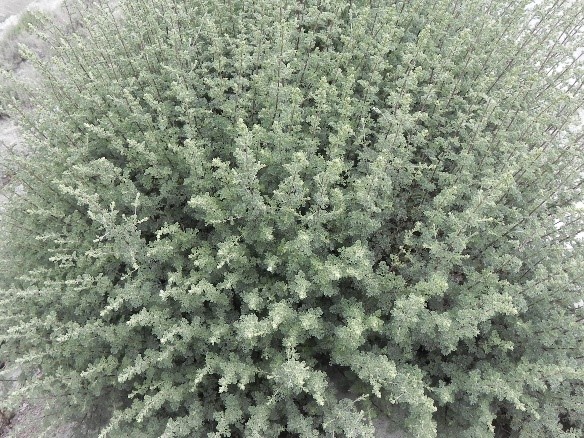 Belonging to Asteraceae family (syn. A. brevifolia), the plant commonly grows wild in the cold desert Himalayan region at altitudes of 4000 m. This plant traditionally used as an insect repellent. Potential use of its essential oil, so far, has remained unexplored. Essential oil yield ranges between 0.3%-0.5 %. Major constituents of the oil are 1,8 Cineole and Sesquiterpene Hydrocarbons. There exists lot of scope for its commercial cultivation in cold desert region
Belonging to Asteraceae family (syn. A. brevifolia), the plant commonly grows wild in the cold desert Himalayan region at altitudes of 4000 m. This plant traditionally used as an insect repellent. Potential use of its essential oil, so far, has remained unexplored. Essential oil yield ranges between 0.3%-0.5 %. Major constituents of the oil are 1,8 Cineole and Sesquiterpene Hydrocarbons. There exists lot of scope for its commercial cultivation in cold desert region
 Rosemary is a stiff, erect bush with dark evergreen green, spiky with narrow leaves perennial, and it grows up to 2 m. The crop comes well in a pH range of 6.5 to 7.0. Cold climate with 15 to 25°C is suitable for growth. Since it is a perennial in nature, can be grown commercially until twelve years. The first harvest of leaves begins from 8 months after planting, and subsequent harvests can be taken at an interval of 3 to 4 months. The average yield of green leaves is 12 to 15 t/ha/year and oil yield of about 85 to 100 kg/ha/year. Oil extracted from the Rosemary is widely used in perfumes, facial and bath soaps and decorative items. Rosemary oil is also used in various health problems, including indigestion, stomachache, and blood pressure.
Rosemary is a stiff, erect bush with dark evergreen green, spiky with narrow leaves perennial, and it grows up to 2 m. The crop comes well in a pH range of 6.5 to 7.0. Cold climate with 15 to 25°C is suitable for growth. Since it is a perennial in nature, can be grown commercially until twelve years. The first harvest of leaves begins from 8 months after planting, and subsequent harvests can be taken at an interval of 3 to 4 months. The average yield of green leaves is 12 to 15 t/ha/year and oil yield of about 85 to 100 kg/ha/year. Oil extracted from the Rosemary is widely used in perfumes, facial and bath soaps and decorative items. Rosemary oil is also used in various health problems, including indigestion, stomachache, and blood pressure.







